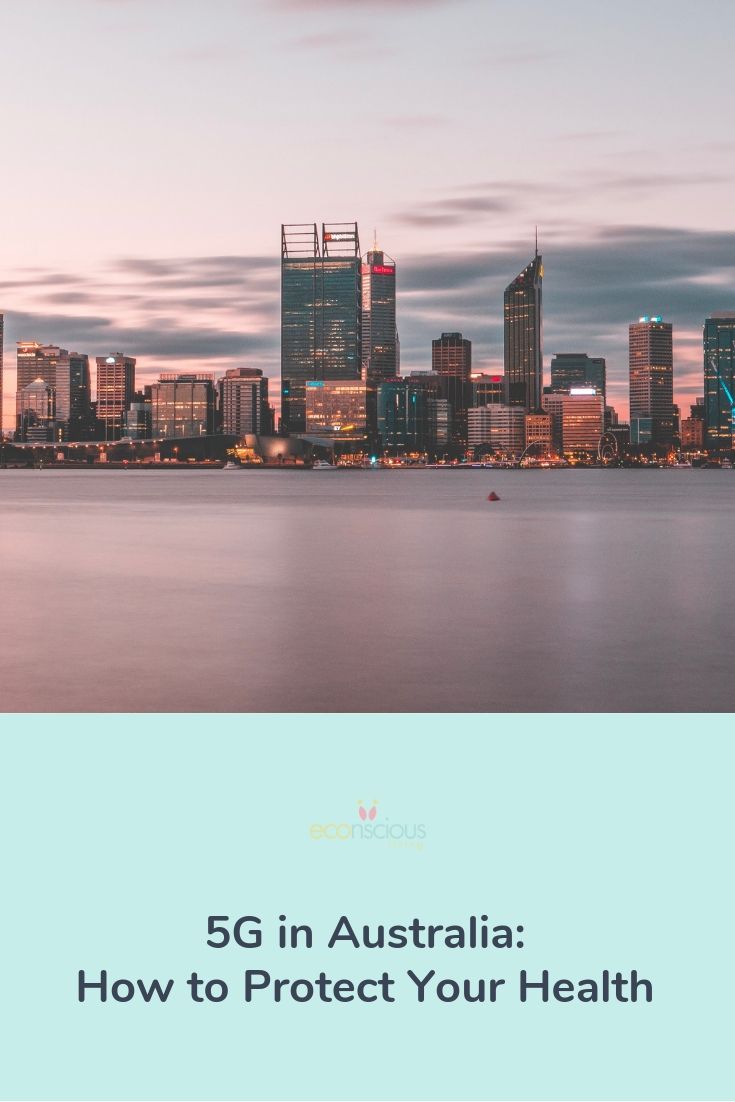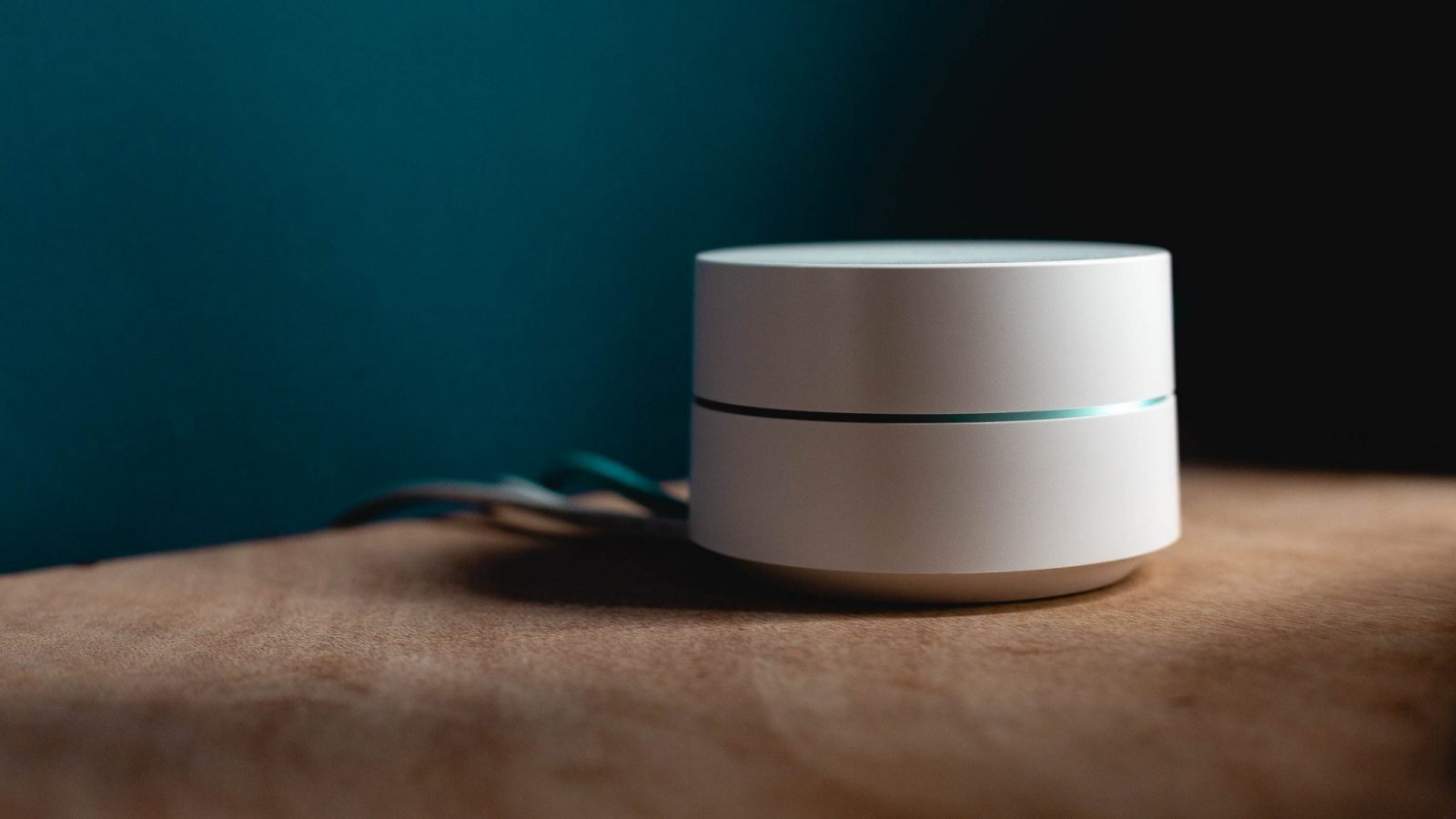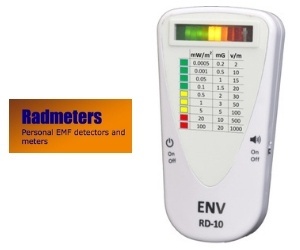5G in Australia & How You Can Protect Your Health
You’re going to hear a lot about 5G in the coming months and years. As network carriers roll out 5G in Australia, we’re being bombarded with television ads and online videos preaching the benefits of this new, apparently faster network. What many of these ads fail to share with us though, is the cost 5G technology may have on our health.
If you’ve visited this blog before, you’ll know I talk a lot about electromagnetic fields, more commonly known as EMF. To understand why 5G in Australia is a risk to our health, you first need to know a little bit about EMF and how this affects us.
TLDR; you can use these links to jump to sections of this post quickly.
What is EMF?
Wireless technology and EMF
What frequencies do Australian networks use?
What exactly is 5G?
Do we need 5G?
Where is 5G rolling out in Australia?
What are the biggest concerns about 5G technology?
5G satellites
What 5G is not
How could EMF from wireless technology affect us?
The scientific evidence
5G in Australia – what it means for our health
What you can do about the 5G rollout
What is EMF?
Put simply, an EMF is a field of energy created by electrically charged objects. There are natural forms of EMF (for example, visible light) on which all life has evolved but this blog focusses on man-made or non-native EMF.
We usually talk in terms of low-frequency or high-frequency EMF or more accurately EMR (electromagnetic radiation).
Low-frequency man-made EMF has been around for over one hundred years since the invention of Thomas Edison’s electric light bulb and Alternating Current (AC) electricity.
High-frequency EMF is a relatively recent phenomenon starting with the development of military radar during World War II but it has really only come to the forefront in the last twenty years with the use of WiFi and mobile phone technology.
High-frequency EMF is sometimes referred to as radiowaves or microwaves. You can’t see or hear it which leaves us very vulnerable to its effects.
I go into more detail about the different types of EMF in these blogs.
Wireless technology and EMF
One of the most significant sources of EMF in our homes and suburbs is wireless technology, for example WiFi, mobile phones towers, our smart devices and anything that uses Bluetooth.
Until recently, wireless networks have included 2G, 3G, and 4G.
The ‘G’ stands for Generation and as we moved up the Generations our means of communication has got more sophisticated and faster.
2G simply gave us voice and text whereas 3G and 4G gave us internet access and smartphones. 2G has been turned off in Australia and New Zealand but 3G remains and 4G is on the rise.
What frequencies do Australian networks use?
Mobile networks currently operate on different bandwidth frequencies measured in megahertz bands.
Long before the advent of mobile phone networks, you will have been familiar with radio bands as they appear every time you tune in your favourite radio station.
The difference is that TV and radio channels use much lower frequencies than mobile networks.
Radio waves can have frequencies as low as 3kHz (kilohertz) but as high as 300 GHz (gigahertz). These radio waves are generated artificially by transmitters and received by radio-receivers using antennas, regardless of whether they are coming from a TV, radio or mobile phone carrier.
Long before we had mobile phone towers, radio or TV masts were spread tens of kilometres apart. There is no need for a dense network of antennas because the lower the frequency the longer the wavelength, meaning we can receive a signal from tens of kilometres away. There’s no need for one on your front doorstep.
This is an important point because the further we move up the EMF spectrum from kilohertz to gigahertz (as is the case for 5G) the shorter the wavelength (we are now talking centimetres or millimetres, not kilometres) and the more powerful it becomes.
This means powerful antennas now need to be located much closer to our homes.

In Australia, 850MHz, 900MHz and 2100Mhz are the common 3G frequencies. Whereas 700MHz, 850Mhz, 900MHz, 1800MHz, 2100MHz, 2300Mhz and 2600MHz are used for 4G, the combination varies depending on the carrier.
The 3G network speeds were great for voice and data, with some of the fastest download speeds available. Yet, as access to 3G increased and lots more data was being transferred, speeds got slower.
So along came 4G LTE or Long Term Evolution, which refers to 4G technology with greater speeds.
4G LTE offers voice and data just like 3G, however, the download speeds are almost twice as fast as its predecessor 3G. LTE allows you to add more spectrum from the same or different bands, allowing for much faster data in larger volumes.
This is another critical point because it means that even today (5G aside), 4G LTE technology is saturating our airways and hence, our chance of avoiding this technology in and around our homes, schools, neighbourhoods, playgrounds and parks is next to impossible.

Bluetooth wireless technology emits EMF
What exactly is 5G?
5G will be another layer of technology on top of the existing and proposed 3G and 4G networks.
Whilst 3G may eventually be phased out, 5G is very reliant on 4G – using the lower frequencies and longer wavelengths to work.
Different countries are deploying different frequencies but here in Australia, we have started by using some relatively low frequencies (700MHz) combined with higher frequencies up to 3.5GHz.
Further down the track, much higher frequencies that start at 26-28GHz and 60GHz, (sometimes referred to as millimetre waves) are predicted to come onstream (more about this later).
This millimetre wave technology was initially developed by the military as a weapon resulting in pain-inflicting weaponised crowd control systems known as active denial systems.
Stand in the way of a beam from one of these at a frequency of 95GHz and you feel like you are on fire as they project a man-sized (1.5m) beam of millimetre waves at up to 1000 meters.
Remember, the higher the frequency the shorter the wavelength and the more powerful they are.
Do we need 5G?
The primary objective of 5G technology is to carry more data.
5G will support about 100 billion devices and will be 10-100 times faster than 4G technology with download speeds that enable you to download a HD movie in under a second.
In a nutshell, 5G is predicted to give us high-speed, ultra-low latency and high bandwidth — all in a wireless communication network.
It will connect about a trillion objects globally. You will often hear it discussed in conjunction with the “Internet of Things’ (IoT). The latter refers to all those smart devices and appliances that will soon enough find their way into your home (if not already).
This will include not only smart TVs but smart fridges and washing machines, toothbrushes, food processors and even nappies (the dumbest idea of all) – all fitted with smart chips continually sending out high-frequency signals.
This data can be sent back to “headquarters” as well as all sorts of marketing agencies, revealing what you watched on TV, what you ate for dinner and so forth.
If you thought it annoying that Facebook presented you with an ad for underpants 10 minutes after you Googled them, well, the IoT will bring your privacy and security (or rather lack of) to a whole new level.
Another technology reliant on 5G technology is driverless cars.
We will have smart cities and towns (which has already begun in Australia) and we will walk from our smart homes, into our smart cars, under smart LED lights, to our smart offices and smart schools. There will be no escape.
You will often hear 5G mentioned in the same breath as Augmented Reality (AR) or Virtual Reality (VR), set to revolutionise everything from our shopping to our gaming experiences. There’s no doubt that the younger generations’ addiction to gaming will reach a whole new level.
At this stage, the penny should have dropped. None of this is smart – it’s completely dumb.
Plus, we haven’t even begun to talk about the health implications of having all these smart chips scattered all over our homes.
Where is 5G rolling out in Australia?
In Australia, the mobile networks are owned and operated by Telstra, Optus and Vodafone.
These networks are all at various stages in the rollout of the 5G network. Of course, the rollout is highly competitive with the race on to install or upgrade base towers, develop 5G enabled smartphones and devices, and get broadband services and routers into our homes as quickly as possible.
For now, in Australia (the USA is different) our 5G technology is using up to 3.5GHz, a step up from 4G but many see it as more of an upgrade of the existing 4G technology.
Across Australia, both Telstra and Optus have installed or upgraded a couple of hundred mobile phone base towers which include 3.5GHz antennas. You can find the location of all these towers (existing and proposed) by following the instructions in my previous blog.
These towers are used to connect with 5G-enabled mobile phones/devices introduced by Telstra earlier this year (Galaxy S10 5G, the OPPO Reno 5G, the LG V50 ThinQ, and the HTC 5G Hub). Optus is soon to follow with its own devices (Note 10+ 5G in September 2019) and Vodafone in 2020.
Basically, if you haven’t bought a 5G enabled phone you can’t make use of this higher frequency. Samsung is also expected to release the first 5G smartphone this year and Apple not until 2020.

Perth is one of ten cities to already have a live 5G mobile network
At the time of writing this post, 10 Australian cities have a live Telstra 5G mobile network: Melbourne, Sydney, Canberra, Brisbane, Adelaide, Perth, Hobart, Launceston, Toowoomba and the Gold Coast. Coverage is primarily available only in the CBDs for now.
Telstra intends to launch 5G in 25 more cities across the next 12 months, including all major regional cities in Australia. Current Telstra 5G coverage is shown on these maps, although it is continually being adjusted.
Optus is in the process of rolling out its 5G mobile network, with 100 sites live in 2019 in various suburbs in NSW, Queensland, ACT, SA and WA. It plans to have switched on 1000 5G sites by March 2020. Optus 5G coverage is shown here.
Optus has already started rolling out its first 5G home broadband service at specific locations in the eastern states based on expressions of interest. While Vodafone is expected to follow suit.
All in all, it will be a few years before we see standard issue 5G-ready phones and modems and there is any sort of comprehensive network coverage.
What are the biggest concerns about 5G technology?
One of the biggest concerns is that in time, 5G technology will use not only the 26-28 GHz bandwidth (scheduled in 2021) but also the very powerful 60GHz millimetre waves (timing unknown).
For now, it’s looking like these higher frequencies will be more suited to densely crowded areas with variable traffic where there is a short and sharp increase in the number of connecting devices – your arenas, sports stadiums, shopping malls and the like. Fortunately, the converse is also true, it’s much less suited to less populated rural areas.
Because millimetre wave networks have a much shorter range it will require the installation of more base stations and small cells.
Whilst large mobile base towers are found everywhere, we haven’t seen small cells before. These are small antennas that are proposed to be installed on lamp posts and utility poles along streets and public areas.
To date, I’ve only seen 4G small cells proposed by Optus in Perth using the 4G LTE 1.8 and 2.4GHz frequencies but these can be upgraded to 5G in time.
The residents in the vicinity of these small cells need to be consulted before these cells can be approved or upgraded. So watch out for those small, subtle notices on your utility poles! Use this website to find those nearest to you.
Millimetre waves do not penetrate obstacles as well as longer wavelengths, a factor that can be used to your advantage when it comes to shielding your home.
The technology will be prone to disruption from the weather (rain), buildings and natural vegetation (trees). Around the world, there has been much criticism of regulatory bodies as trees are felled to apparently make way for this new technology.
Telstra says it has no small cells currently scheduled but as part of the Federal Government’s Mobile Black Spots program, it has committed to funding up to 250 4G LTE small cells in remote areas and Optus 49 satellite small cells.
So for now, it looks like the base towers and small cells will use a combination of frequencies up to 3.5GHz, as any move to millimetre waves is yet to be deemed commercially and technically viable.
Unfortunately, it gets worse… enter 5G satellites
At least five companies are proposing to give us 5G from space using about 20,000 satellites. Each satellite will emit millimetre waves from thousands of antennas that will cover the Earth with powerful, focused beams.
These satellites will be located in the Earth’s magnetosphere, which plays a huge role in our climate and weather. You don’t need to be a scientist to understand that tampering with the Earth’s natural electromagnetic field has to be a very stupid idea.
Whilst the energy that will eventually reach the ground from satellites will be less than that from ground-based antennas, it will irradiate remote parts of the Earth not reached before.
Very little information is available on how 5G from space will actually work so it remains to be seen how it will all eventuate and how viable it will be.
A note on what 5G is not
5GHz does not equal 5G.
Many of you will see 5GHz pop up when you are connecting to your modem/router. Up until recently standard-issue routers only used the 2.4GHz frequency (just like your microwave and baby monitor). But more and more standard-issue routers have two channels: 2.4GHz and 5GHz.
When I visit clients’ homes one of the first pieces of advice I give them is to switch off the 5GHz channel. None of us has asked for this powerful wavelength and I’m sure most of us do not need it.
Again, the lower the number the longer the wavelength but the less power it packs; the higher the number the shorter the wavelength but the more powerful it is.
Let’s face it, neither frequency is good in terms of your health but the more you can reduce the load in your home the better.
How could EMF from wireless technology affect us?
When doctors measure the natural electric field of our bodies using an ECG, it’s measured at 8-10 Hz per second or 8 to 10 waveforms per second.
5G aside, a standard 2.4GHz router in your home technology will expose you to about 2.4 billion waveforms per second hitting your body.
The question is not ‘how could EMF from wireless technology affect our health’ but how could it not?
The potential effects of this man-made EMF on the naturally-occurring electromagnetic fields that our biology has evolved on has not been taken account of in our safety exposure limits.
Our exposure guidelines only take account of heating (or thermal) effects on our body and they don’t even do that very well as many mobile phones and devices exceed these guidelines on or near the body.
Similarly, we don’t know enough about the effects on animals and plants, or the atmosphere.

We don’t know enough about the effects of EMF on animals and plant life
The last 25 years have seen a massive reduction in our global bee, insect and bird population, species that rely on the earth’s magnetic field to navigate.
In 2000, a remarkable study found that a robin’s magnetic compass or navigation sense comes directly from a cryptochrome behind the bird’s eye. It’s believed birds literally ‘see’ the earth’s magnetic field which allows them to orient while flying.
When exposed to high-frequency EMF (think WiFi) during the study, their migration was disturbed at very low levels, way lower than our regulations currently allow us all to bathe in.
The radiation we are being exposed to from man-made EMF today is millions of times greater than it was 25, or even 10 years ago.
How much more? In a 3G world, a quintillion times more. That’s a 1 with 18 zeros.
What happens when 5G is bestowed on us all?
The scientific evidence
In 2011, the International Association for Research on Cancer (IARC) and the World Health Organisation (WHO) categorised wireless radiation as a ‘possible’ carcinogen (Group 2b); a cancer-causing substance.
That is in the same category as DDT, tobacco smoke, diesel exhaust, welding fumes, formaldehyde and asbestos. Would you allow your children to sit in a classroom with these toxic mixtures? Surely, we will look back in time and wonder what the hell were we thinking of allowing WiFi into our homes and schools?
Many science experts believe there is now more than sufficient evidence for wireless radiation to be re-categorised as either a ‘probable’ or ‘known’ carcinogen.
Another irony is that we use man-made EMF frequencies in medicine.
It’s a useful tool in treating brain cancer because it helps open the blood-brain barrier allowing better uptake of chemotherapy drugs. This effect on the blood-brain barrier is disastrous in other ways because it gives highly toxic contaminants a free pass into the brain such as mercury, aluminium which are strongly linked to neurodegenerative diseases such as Alzheimer’s Disease and Parkinson’s Disease.
Indeed, researchers have demonstrated through long-term research that exposure to low-level microwave radiation from wireless devices can cause the blood-brain barrier to open for 2 weeks or more.
The findings from two large long-term studies looking at the effects of both near-field (2G and 3G mobile phones) and far-field EMF radiation (1.8GHz GSM base station) were released last year.
Male rats in both studies developed schwannomas of the heart and tumours of the brain at statistically higher rates than control animals that were not exposed. More detail on these studies, the largest of their kind ever undertaken and can be found here and here.
These laboratory studies, along with an ever-increasing volume of scientific evidence suggests that prolonged exposure to radiofrequency EMF has significant biological, health effects.
These effects are serious including infertility, miscarriages, cancer, immune dysfunction, autoimmunity, foetal stress, anti-biotic resistant bacteria and many more.
Because of this large volume of independent research, the International EMF Scientist Appeal to the United Nations Environment Programme (250 peer-reviewed scientists representing 42 countries) has requested it reassesses the potential biological impacts of next-generation 4G and 5G telecommunication technologies to plants, animals and humans.
However, public exposure regulations in most countries are based on the guidelines of the International Commission on Non-Ionizing Radiation Protection (ICNIRP).
These guidelines were established in the 1990s (long before the onslaught in wireless technology) and they are based on the premise that only acute thermal (heating) effects are damaging to our health.
The sheer volume of quality scientific evidence available refutes the claim by International and Australian regulatory authorities (ICNIRP and ARPANSA) that the rollout of wireless technologies poses no health risks at the currently allowed exposure levels.
I’ve included links to a number of these peer-reviewed research articles at the end of this post, in case you would like to read about these in more detail.
5G in Australia – what it means for our health
All of the studies and information I’ve shared with you so far are based on the types of wireless technologies we have had up until now. I’m sure you’ll agree, none of this is good!
5G technology, especially if it is deployed to the full extent in millimetre waves, is a whole new ball game.
As Dr Joel Moskowitz, a public health professor at the University of California put it:
‘The deployment of 5G, or fifth-generation cellular technology, constitutes a massive experiment on the health of all species.”
Dr Martin Pall., PhD and Professor Emeritus of Biochemistry and Basic Medical Sciences at Washington State University are an authoritarian on the subject. He wrote a 90-page document on EMF effects and how they are produced in the body.
He says “Putting in tens of millions of 5G antennae without a single biological test of safety has got to be about the stupidest idea anyone has had in the history of the world”.
In the report he states “there is a massive literature, providing a high level of scientific certainty, for each of eight pathophysiological effects caused by non-thermal microwave frequency EMF exposures.” This will include an unprecedented increase in many diseases, including:
- Widespread neurological and neuropsychiatric effects
- Oxidative stress and free radical damage central roles to all chronic diseases
- Blindness from each of the four major causes of blindness: cataracts, macular degeneration, glaucoma and retinal detachment.
- Hearing loss and tinnitus, leading to deafness
- Neurodegeneration and increased infertility
- Many types of cancer (single-strand and double-strand breaks) particularly in children as well as germ mutations affecting future generations
- Attacks on our endocrine/hormonal systems including autoimmune diseases
- Excessive intracellular calcium and excessive calcium signalling
But this information is not new at all.
For decades hundreds of studies have been published on the health concerns regarding EMF.
What is new is the health impacts that are predicted from the short millimetre wavelengths. 5G sub-THz (high gigahertz) band wavelengths are not the same size as the longer wavelengths used in 2G, 3G and 4G technology.
The longer wavelengths used in 2G, 3G and 4G technology do not preferentially absorb into human sweat ducts due to their size but physicists Yuri Feldman and Paul Ben-Ishai found that the millimetre waves central to 5G technology uniquely penetrate the skin with a very high absorption rate in the sweat ducts, rendering it an antenna on your body.
We will become walking antennas to EMF, and as a result, skin diseases are expected to significantly increase including melanomas.
As I mentioned earlier, the 24-26GHz and 60GHz millimetre wavelengths are likely to be rolled out in 2021 and beyond, starting with the former.
What you can do about the 5G rollout
In light of the evidence that 5G on top of 4G technology will bring about widespread illness to human health and the environment, we call on our Councillors (who have the power to stop the installation of towers) and our regulators (ARPANSA) to implement the precautionary principle.
The precautionary principle forms a statutory part of environmental regulation around the world including Australia and is one I’ve used over and over in my work as an environmental scientist.
What exactly does it mean?
“When an activity raises threats of harm to human health or the environment, precautionary measures should be taken even if some cause and effect relationships are not fully established scientifically.”
Man-made EMF exposure is environmental pollution of the highest degree.
If your neighbour or local pub shone a light or played loud music next door to you all day and night would you tolerate it? Why is man-made EMF any different? Only because we can’t see it or hear it but unfortunately your body is still paying the toll.
Technically, under Australian legislation (Criminal Codes), you are being assaulted or threatened with assault from electromagnetic radiation when utility companies don’t cease emissions from an existing or proposed tower when a complaint is formally lodged. You can read more about the legal avenues available to you here.
Call it what you want, 4G or 5G, the truth is the air we breathe in and around our homes is being saturated by man-made EMF and none of it is good. Here are some simple steps you can take to protect your family.
1. Get your own house in order first
Either buy an EMF meter or get an EMF professional to assess and jump-start the process for you. Protesting about the ill-effects of 5G is all well and good but if you are still running your WiFi router 24/7, heating your food in a microwave, living under fluorescent or LED lights, and sleeping in a high AC magnetic field due to wiring errors or nearby powerlines, you are swimming in man-made EMF.
For most people, the biggest source of exposure to EMF in their daily lives will be their router/modem – hard-wire an ethernet connection and then move on to the rest. You will find lots of action steps to get you on your way in my online EMF Kickstarter booklet.
2. Vote with your dollar and don’t buy any 5G-enabled technology
This includes 5G phones or routers/modems to avoid 5G towers or cells beaming at you and your home. It also sends a message to the manufacturers and regulators that we don’t support this unsafe technology.
3. Don’t buy any sort of smart device or appliance for your home
If you already have smart devices have them deactivated and/or the chip removed. For advice on smart meters read this blog.
4. Support the NBN
NBN (the National Broadband Network in Australia) uses fibre optic cable which in itself is safe and fast. Fibre optic is also technically faster than any wireless technology (much of what you hear about super-fast 5G speeds is hype).
The health issue with NBN is the wireless modems/routers that you get with them, not the fibre optic cable itself. Again, watch out for 5G-enabled NBN routers/modems which are also likely to eventually come on board.
5. Assess external sources of EMF
If neighbouring routers/modems or mobile phone towers are causing you a problem you need to find a practical solution. If you rent, you can move but if you own your home moving might not be as straightforward.
In this case, you may need to use special shielding paints and window fabrics.
There are some great products on the market which more than cover the frequencies used in the current 5G roll-out. But this is something you definitely need advice on to ensure you don’t do more harm than good and to ensure what you are buying is suitable based on your EMF exposures.
Based on current speculations in Australia that the higher frequency wavelengths will be restricted to arenas and stadiums etc. there may never be a need to shield your home from these higher frequencies.

Tall trees can help protect against certain types of EMF
6. Start planting tall trees!
Planting tall trees that don’t shed their leaves in winter, especially those of the sap variety (e.g. rubber trees) can protect your home from certain types of EMF.
7. Consider a home with a metal roof
Seek advice from an EMF professional on whether a metal roof will help your situation. If you are doing all the right things and reducing EMF inside your home this can be a great way to protect you somewhat from mobile phone towers and possibly even 5G satellite.
8. Location, location, location
Where you live and the natural shielding you get from your surrounding environment can play a huge role in either protecting or exposing you to external sources of EMF.
Read all about it in my blog here where you can also take a short quiz to help you assess your exposure risk.
9. Start working on improving your mitochondrial health
90% or more of our diseases today are due to mitochondrial disease (not genetics). Whether it is 3G, 4G or 5G your mitochondria are being hammered by man-made EMF.
Natural light, pure high-quality water and low-EMF environments are what make your mitochondria sing.
Contact me to get hold of my soon to be released Educational Guideline on ‘Detoxing from EMFs’, where I will give you all the tricks in the trade and lifestyle advice on protecting yourself and your family from EMF.
10. Contact your local Councillor
Inform your local Councillor of the health implications of 5G and their duty to enforce the precautionary principle. To be fair, most of them, like the public at large, are just not aware of the health risk.
Both 4G and 5G base towers have already been knocked back by Councils around Australia. Sometimes all it takes is a few concerned residents coming together with their Council to inform them of the dangers.
You will find stacks of invaluable resources at the We Say No to 5G in Australia website including a list of the 5G Action Groups across Australia.
I appreciate this blog post has given you a lot of information to digest! Taking action against EMF and the 5G rollout doesn’t have to overwhelm you though and I hope you have got the message that there is much you can control.
I offer in-home and online EMF assessments that are designed to empower you to make the changes you need to protect your family.
Request an EMF assessment and start taking action.
References
http://jnlwp.defense.gov/About/Frequently-Asked-Questions/Active-Denial-System-FAQs/
http://www.whistleout.com.au/MobilePhones/Guides/Will-my-phone-work-in-Australia-carrier-network-frequencies
http://www.rfsafe.com/5g-network-uses-nearly-same-frequency-as-weaponized-crowd-control-systems/
http://www.acma.gov.au/theACMA/a-guide-to-small-cells
http://www.telstra.com.au/coverage-networks/our-coverage
http://www.optus.com.au/about/media-centre/media-releases/2019/05/Optus-to-connect-next-round-of-5G-Customers
http://www.techrepublic.com/article/5g-mobile-networks-a-cheat-sheet/
http://www.sciencedirect.com/science/article/pii/S0013935118300367?via%3Dihub
http://www.scientificamerican.com/article/new-studies-link-cell-phone-radiation-with-cancer/
http://ehtrust.org/scientific-research-on-5g-and-health/
http://bioinitiative.org/
http://www.powerwatch.org.uk/science/studies.asp
http://www.thelancet.com/journals/lanplh/article/PIIS2542-5196(18)30221-3/fulltext
http://citizensfor5gawareness.org/5g-is-the-stupidest-idea-in-the-history-of-the-world-says-washington-state-professor/
http://peaceinspace.blogs.com/files/5g-emf-hazards–dr-martin-l.-pall–eu-emf2018-6-11us3.pdfhttp://static1.squarespace.com/static/55075f84e4b0f11bacb1b8d0/t/5cddce600d71620001cd7dc3/1558040165559/On-the-Clear-Evidence-of-the-Risks-to-Children-from-Smartphone-and-WiFi-Radio-Frequency-Radiation_Final.pdf
http://www.5gspaceappeal.org/the-appeal
http://ehtrust.org/key-issues/the-environment-and-health/wireless-radiationelectromagnetic-fields-increases-toxic-body-burden/
http://www.ncbi.nlm.nih.gov/pmc/articles/PMC6040147/
This blog post contains affiliate links, which means that if you buy one of the products I recommend through a link here, I earn a tiny commission. I only recommend products that I, myself, use. I will never recommend to you something that I haven’t tried and tested! Please feel free to send me a message if you want to know more about any of the products I share on the blog.
Related Posts
What light is best for sleep?
What most of us don’t know is that the quality of our sleep is controlled by our light environment: both day and night.
The Best Natural Pillows For Better Sleep
If you truly want to make a simple upgrade in the bedroom that will change your health then keep reading to find the best natural pillows for better sleep
Why You Should Have a Home Sauna for Better Health
Quite simply if there was a pill that did ALL the things that research is showing us saunas do, you would be taking it. Here’s why and my recommendations















Thank you for sharing this information
As a holistic dentist I am aware of potential issues with EMR and dental and overall wellness. Very clear article with great content.
Good stuff, Una. I have been listening to the 5G Summit from the US this week. It ends tomorrow. Vital info and includes a talk from Dr Pall whom you mentioned.
I have contacted my idiot council (Coffs Harbour) with all sorts of info and still things are proceeding. 5G will be switched on about 1km from my home within the month. I am a homeowner. I am also healthy and aware, but I am frightened. The tower has been 4G since 2013. I do not sleep well, have anxiety, depression, you name it. I do not want cancer. There is a solicitor from Tassie who tells us how to stop these or get them removed. Because it is causing Harm, or if our doctors agree that these are not safe and that we are worried about harm being caused, then this is an ASSAULT. This fellow, Raymond Broomhall, treats these as criminal assaults and is winning lots of rounds against the Telcos. But I think at a great monetary cost. I have joined all the anti 5G groups on Facebook and signed lots of petitions. But as Pall said, this could be the of civilisation. And certainly we will have more fires after 5G is everywhere.
Good information i need to get ready for the disaster thank you Una